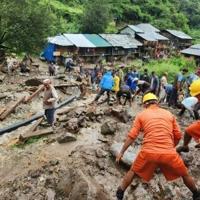Flash floods caused by monsoon downpours in India’s Himalayan foothills have resulted in the tragic deaths of 13 individuals, officials announced on Friday. Helicopters have been deployed to rescue hundreds of people stranded near a popular Hindu shrine.
The occurrence of flooding and landslides is not uncommon during India’s perilous monsoon season, however, experts believe that climate change is amplifying their frequency and severity.
As of now, reports confirm a death toll of thirteen across the northern state of Uttarakhand, according to disaster official Vinod Kumar Suman in statements to AFP.
District authorities have disclosed that approximately 700 individuals were rescued via airlift while en route to the Kedarnath temple, a significant pilgrimage site devoted to the Hindu deity Shiva.
“We are utilizing multiple helicopters to safely transport the pilgrims who were on their journey,” Suman remarked.
Situated at an elevation of nearly 3,600 meters (11,800 feet) above sea level, access to the temple is only feasible during the summer through a challenging 22-kilometer (14-mile) uphill trek.
Every year, the temple attracts a multitude of pilgrims at a time when the yearly monsoon rains reach their zenith.
The monsoon showers, occurring from June to September throughout the region, offer relief from the scorching summer temperatures and are crucial for replenishing water reserves.
These rains play a pivotal role in agriculture, thereby sustaining the livelihoods of millions of farmers and ensuring food security for nearly two billion individuals in South Asia.
This week, over 200 people lost their lives in the southern state of Kerala when landslides struck villages and tea plantations, with ongoing search and rescue missions in progress.
In the neighboring state of Himachal Pradesh, two individuals perished this week, and rescuers are currently scouring for more than two dozen individuals who have been reported missing.
str-sai/gle/fox





